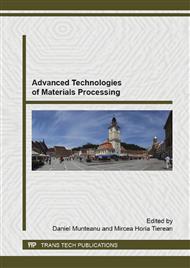[1]
M. Rosso, I. Peter, Defect Control on Al Castings for Excellent Quality and Improved Performances through Novel Rheocasting Processes, Proc. TMS 1 (2012) 403-410.
DOI: 10.1002/9781118357002.ch52
Google Scholar
[2]
H. J. Schmidt, B. Schmidt-Brandecker, Aluminium casting, Proc. ICAA13 1 (2012) 461-470.
Google Scholar
[3]
J. C. Williams, E.A. Starke, Stabilization of metallic supercooled liquid and bulk amorphous alloys Acta Materialia 51 (2003) 5775–5799.
Google Scholar
[4]
E. A. Starke, Aluminum castings, Journal of the Japan Institute of Light Metals 51 (2001) 77-85.
Google Scholar
[5]
V. Bratu, I.N. Popescu, Variation of mechanical properties with temperature for an ecomaterial J. Optoelectron. Adv. Mater., 15 (2013) 853 – 857.
Google Scholar
[6]
F.V. Anghelina, V. Bratu, E.V. Stoian, I. N. Popescu, submitted to Advanced Materials Research: (2014).
Google Scholar
[7]
G. Popescu, I. Gheorghe, F. Dănilă, P. Moldovan, Vacuum Degassing of Aluminium Alloys, Materials Science Forum 217-222 (1996) 147-152.
DOI: 10.4028/www.scientific.net/msf.217-222.147
Google Scholar
[8]
I. Lichioiu, I. Peter, B. Varga, M. Rosso, Preparation and Structural Characterization of Rapidly Solidified Al–Cu Alloys, J. Mater. Sci. & Technol. 30 (2014) 394-400.
DOI: 10.1016/j.jmst.2013.12.001
Google Scholar
[9]
C. Nicolicescu, M. Ciobanu., L. Leonat, Influence of the Mechanical Alloying Parameters on the Elaboration of Sic/Al Nanocomposite Powders, Materials Science Forum 672 (2011) 219-222.
DOI: 10.4028/www.scientific.net/msf.672.219
Google Scholar
[10]
J.C. Jacquet, M. Heckler, Aluminium casting and alloys, Aluminium RFG 59 (1982) 340-345.
Google Scholar
[11]
I.N. Popescu. V. Bratu, M. Rosso, C. Popescu, E. V. Stoian, Designing and continuous extrusion forming of Al-Mg-Si contact lines for electric railway, J. Optoelectron. Adv. Mater 15 (2013) 712-717.
Google Scholar
[12]
C. O. Rusănescu. M. Rusănescu, The influence of the residual copper on the pipes steel hot plasticity according to environmental requirements, J. Min. Metall. Sect. B-Metall. 49 B (2013) 353 – 356.
DOI: 10.2298/jmmb130124036r
Google Scholar
[13]
C. O. Rusănescu. M. Rusănescu. T. Iordănescu. F. V. Anghelina, Mathematical relationships between alloying elements and technological deformability indexes, J. Optoelectron. Adv. Mater 15 (2013) 718 – 723.
Google Scholar
[14]
I.N. Popescu, R. Vidu, V. Bratu, A.B. Olei, D.N. Ungureanu, F.V. Anghelina, Effects of Silicon Carbide Proportion and Artificial Aging Parameters on Microstructure and Hardness of Al-Cu/SiCp Composites, Solid State Phenomena 216 (2014) 122-127.
DOI: 10.4028/www.scientific.net/ssp.216.122
Google Scholar
[15]
BS EN 2048: 2001 Aerospace series. Extruded L-section in aluminium alloys. Dimensions.
Google Scholar
[16]
Gh. Ioniţă. L. G. Toma, Elaboration of non-ferrous alloys, experimental works and applications (in Romanian), Macarie Press, Targoviste, (1996).
Google Scholar
[17]
I. Minkoff, Solidification and cast structure, Wiley, New York, (1986).
Google Scholar
[18]
T.M. Moltev, Modification of the metals structure. (in Romanian translated from Russian), Bucharest, Ed. Tehnica, (1966).
Google Scholar
[19]
I. Dragomir, V. Bratu, Structura şi proprietăţile topiturilor metalice/ The structure and properties of the molten metal (in Romanian) Macarie press, Târgovişte. (2002).
Google Scholar
[20]
D. M. Stefanescu, Science and Engineering of Casting Solidification, Springer, 2nd Ed. Berlin, (2009).
Google Scholar
[21]
A. Gaba, A. Catangiu, V.F. Anghelina, Design and experimental results of high temperature tundish heater, Metall. Int. 14 (2009) 61–65.
Google Scholar
[22]
A. R. Eivani, J. Zhou, J. Duszczyk, Recent Trends in Processing and Degradation of Aluminium Alloys, Edited by. Zaki Ahmad, pp.478-514.
Google Scholar
[23]
V. Bratu, I.N. Popescu, FV Anghelina, D.N. Ungureanu, M.C. Enescu, Determination of solidification front'position by using tungsten at continuous casting of lead-based non-ferrous semi-products, Metalurgia International 16 (4) 81-84.
Google Scholar
[24]
I. Peter, M. Rosso, Aluminium alloys, Proc. ICAA13 1 (2012) 177-182.
Google Scholar


